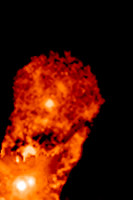 A visual band light curve for XZ Tauri. The main plot shows the long-term variability, and the inset shows the year 2000 superflare on the north star. Adapted from Dodin et al. (2016)[1] and Coffey et al. (2004).[2] | |
| Observation data Epoch J2000.0 Equinox J2000.0 | |
|---|---|
| Constellation | Taurus |
| Right ascension | 04h 31m 40.08690s[3] |
| Declination | +18° 13′ 56.6424″[3] |
| Apparent magnitude (V) | 10.40[4] |
| Characteristics | |
| Spectral type | M2.0 + M3.5[5] |
| Astrometry | |
| Proper motion (μ) | RA: 9.1[6] mas/yr Dec.: −17.8[6] mas/yr |
| Distance | 460 ly (140[7] pc) |
| Orbit[8] | |
| Primary | A[a] |
| Companion | B |
| Period (P) | 155 yr |
| Semi-major axis (a) | 0.172+0.002 −0.003″ |
| Eccentricity (e) | 0.742+0.025 −0.034 |
| Inclination (i) | 0.0° |
| Argument of periastron (ω) (secondary) | −42.2+2.0 −4.7° |
| Details[5] | |
| A[a] | |
| Mass | 0.37 M☉ |
| Radius | 1.1 R☉ |
| Luminosity | 0.17 L☉ |
| B | |
| Mass | 0.29 M☉ |
| Radius | 1.7 R☉ |
| Luminosity | 0.31 L☉ |
| Temperature | 3,550[7] K |
| Age | 4.6[7] Myr |
| Other designations | |
| Database references | |
| SIMBAD | data |
XZ Tauri is a binary system approximately 460 light-years away in the constellation Taurus. The system consists of two T Tauri stars orbiting each other about 6 billion kilometers apart (roughly the same distance as Pluto is from the Sun). The system made news in 2000 when a superflare was observed in the system.
A third star, component C, has been observed at a separation of 0.09″, but subsequent observations failed to find it.[10][8] The T Tauri star HL Tauri, 23″ away, is also sometimes listed as a companion.[9]
YouTube Encyclopedic
-
1/5Views:3 85610 8808 49613 0899 429
-
Classroom Aid - XZ and HL Tauri
-
Classroom Aid - T Tauri Stars
-
Classroom Aid - Tunneling through the Coulomb Barrier
-
Classroom Aid - When Stars Run Out of Hydrogen
-
Classroom Aid - Star Age Introduction
Transcription
Gallery
-
-
An animation of the 2000 superflare in the system.
Notes
- ^ a b Sources vary on their definitions of the primary and secondary components. A is defined here as the more massive component, with a lower temperature but higher luminosity. Other sources refer to the components as north and south,[2] or Aa and Ab.[9] The southerly star Ab is generally brighter at optical wavelengths and more massive, but is less luminous.
References
- ^ Dodin, A. V.; Emelyanov, N. V.; Zharova, A. V.; Lamzin, S. A.; Malogolovets, E. V.; Roe, J. M. (January 2016). "Orbital motions and light curves of young binaries XZ Tau and VY Tau". Astronomy Letters. 42 (1): 29–40. arXiv:1509.04966. Bibcode:2016AstL...42...29D. doi:10.1134/S1063773716010035. S2CID 118495210.
- ^ a b Coffey, D.; Downes, T. P.; Ray, T. P. (May 2004). "The evolution and simulation of the outburst from XZ Tauri – A possible EXor?". Astronomy and Astrophysics. 419 (2): 593–598. arXiv:astro-ph/0402635. Bibcode:2004A&A...419..593C. doi:10.1051/0004-6361:20034316. S2CID 17421498.
- ^ a b Brown, A. G. A.; et al. (Gaia collaboration) (August 2018). "Gaia Data Release 2: Summary of the contents and survey properties". Astronomy & Astrophysics. 616. A1. arXiv:1804.09365. Bibcode:2018A&A...616A...1G. doi:10.1051/0004-6361/201833051. Gaia DR2 record for this source at VizieR.
- ^ Ducati, J. R. (2002). "VizieR Online Data Catalog: Catalogue of Stellar Photometry in Johnson's 11-color system". CDS/ADC Collection of Electronic Catalogues. 2237. Bibcode:2002yCat.2237....0D.
- ^ a b Hartigan, Patrick; Kenyon, Scott J. (January 2003). "A Spectroscopic Survey of Subarcsecond Binaries in the Taurus-Auriga Dark Cloud with the Hubble Space Telescope". The Astrophysical Journal. 583 (1): 334–357. arXiv:astro-ph/0209608. Bibcode:2003ApJ...583..334H. doi:10.1086/345293. S2CID 10433035.
- ^ a b Zacharias, N.; Urban, S. E.; Zacharias, M. I.; Wycoff, G. L.; Hall, D. M.; Germain, M. E.; Holdenried, E. R.; Winter, L. (2003). "UCAC2 Catalogue (Zacharias+ 2004)". Vizier Online Data Catalog. Bibcode:2003yCat.1289....0Z.
- ^ a b c Osorio, Mayra; et al. (July 2016). "A Dwarf Transitional Protoplanetary Disk around XZ Tau B". The Astrophysical Journal Letters. 825 (1): 6. arXiv:1606.03118. Bibcode:2016ApJ...825L..10O. doi:10.3847/2041-8205/825/1/L10. S2CID 59585588. L10.
- ^ a b Ichikawa, Takanori; Kido, Miyu; Takaishi, Daisuke; Shimajiri, Yoshito; Tsukamoto, Yusuke; Takakuwa, Shigehisa (2021). "Misaligned Circumstellar Disks and Orbital Motion of the Young Binary XZ Tau". The Astrophysical Journal. 919 (1): 55. arXiv:2106.11924. Bibcode:2021ApJ...919...55I. doi:10.3847/1538-4357/ac0dc3. S2CID 235593373.
- ^ a b c "XZ Tau". SIMBAD. Centre de données astronomiques de Strasbourg. Retrieved 2020-12-09.
- ^ Osorio, Mayra; MacÍas, Enrique; Anglada, Guillem; Carrasco-González, Carlos; Galván-Madrid, Roberto; Zapata, Luis; Calvet, Nuria; Gómez, José F.; Nagel, Erick; Rodríguez, Luis F.; Torrelles, José M.; Zhu, Zhaohuan (2016). "A Dwarf Transitional Protoplanetary Disk Around Xz Tau B". The Astrophysical Journal. 825 (1): L10. arXiv:1606.03118. Bibcode:2016ApJ...825L..10O. doi:10.3847/2041-8205/825/1/L10. S2CID 59585588.
- ^ "Jets, bubbles, and bursts of light in Taurus". www.spacetelescope.org. ESA/Hubble. Retrieved 6 November 2014.
External links
- "Movies from Hubble Show the Changing Faces of Infant Stars". HubbleSite. NASA. 21 September 2000. Retrieved 23 August 2009.
- XZ Tauri at Constellation Guide

![Hubble image of XZ Tauri.[11]](http://upload.wikimedia.org/wikipedia/commons/thumb/b/bc/Heic1424a.tif/lossy-page1-200px-Heic1424a.tif.jpg)
